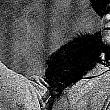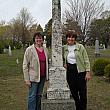"Additional Notes on the Passenger Pigeon"
by Etta S. Wilson
 Individually and in flocks the Passenger Pigeon (Ectopistes migratorious) was a guileless bird, gentle and timid but not afraid. It could be easily approached in tree or shrub or along the roadway.
Individually and in flocks the Passenger Pigeon (Ectopistes migratorious) was a guileless bird, gentle and timid but not afraid. It could be easily approached in tree or shrub or along the roadway.
Feeding about in small social groups they exhibited the essence of contentment, softly uttering their conversational note, a high-pitched keek-keek and bobbing the head in characteristic fashion as they walked or ran about finding food bits, never fighting over the morsel. The quality of the note was slightly husky and there was a perceptible hesitancy as though the individual was a bit out of breath; but the note could rise to a scream when the bird was terrorized. Under torture it was silent.
As they stood their erect attitude was one of great dignity and grace, showing not only their lovely vermilion eyes, the beautiful bluish-slate of the upperparts but the rare pinkish chestnut of the throat and breast. A half-inch fringe of soft white feathers drooped down over the pinkish-red tarsus and was know as the “pigeon’s panties.”
Doubtless in feeding every form of wild berry and many seeds were eaten. The Leelanau county birds were believed never to go over the water to the mainland or to the southward of the “roost” to feed but to have taken all their food, at least during the nesting season, within the confines of the county, surrounded as it is on three sides by the waters of Lake Michigan and Grand Traverse Bay. Proof of this seems to be found in the fact that although Pigeons were very fond of huckleberries and fed upon them almost exclusively where they were abundant, this type of berry was never found in their stomachs. Huckleberries did not grow in Leelanau County but were plentiful in Grand Traverse County immediately to the south.
A bird killed outright fell from the flock like a plummet, but one wounded came down in a long slanting line, some being found quite a distance from the hunter’s stand. When the shooting season opened wounded birds were easy to locate on the all but bare ground but when the grass started to grow it was often difficult to find them even when the direction of descent was observed. Usually a wounded bird would lie mute and still until approached by a dog or a person when it might flutter feebly and so disclose its position.
Some birds suffered great lacerations while others seemed to have been killed by a single lead pellet. Legs were seldom damaged except as secondary hurts since in normal flight they were drawn up under the body. Advancing Pigeons received the charge in the face, as only a novice would waste ammunition by firing at a flock after it had passed; so it often happened that many of the victims literally “took it on the chin,” their bills and parts of the head or face shot off or their eyes shot out. Most common were wing injuries which did not kill instantly like body shots.
I believe I began to retrieve Pigeons when I was about three years old since I can remember creeping about in the grass which was so tall in late June that I could scarcely see over it, and I have held in my hands birds still living which had suffered almost every possible form of mutilation, some gasping for breath, some bleeding silently, some struggling feebly, and some lying inert in agony while life’s forces ebbed away.
The sale of the birds was regulated by the severity of their injuries. After the most desirable ones were disposed of the remainder, 44 dozen to a barrel, were sold for what they would bring.
Once we had a pet Pigeon, a female which we names “Partie,” The bird had come down, slightly injured, and was captured and cared for in our home until its hurts were healed which was about the close of the season for migrating Pigeons. Partie was permitted the liberty of the house and showed great affection for the various members of the family but was particularly partial to my mother to whose shoulder she would fly and remain while mother walked about busy with duties, every now and then reaching up to caress mother’s cheek with her slick little head. Partie always slept in an opening among the books on a built-in shelf over a bedroom door, squatted down on her pink feet, and with her head neatly tucked under the broken wing which had mended without permanent disability although a few feathers had been lost. Each day she was furnished with a new bed of soft newspapers.
Traffic in live birds was enormous and profitable. Nets spread over a baited area in old fields would bring in from 700 to 800 birds at on spring of the trap and these live birds brought the highest price. Cooped in the poultry crates they could be kept for months with little loss and were mainly purchased by the trap shooting clubs for live targets. The “clay pigeon” is a relic of the time when live birds were used, but live birds were not considered the best kind of a target, except when first caught and still lively. After weeks, and sometimes months of incarceration in limited quarters they became “lazy and logy” and did not fly swiftly from the trap when released. Finally some one with a bright mind conceived the idea of cutting off the toes of the bird when it was placed in the trap. Then when released it went up like a rocket.
Naturally there were no trap shooters in the Pigeon territory but this story was commonly told and believed. Doubtless countless instances of this last unspeakable cruelty brought to an end many individuals of one of God’s most gentle and beautiful creatures.
9077 Clarendon Ave., Detroit.

 facebook
facebook




